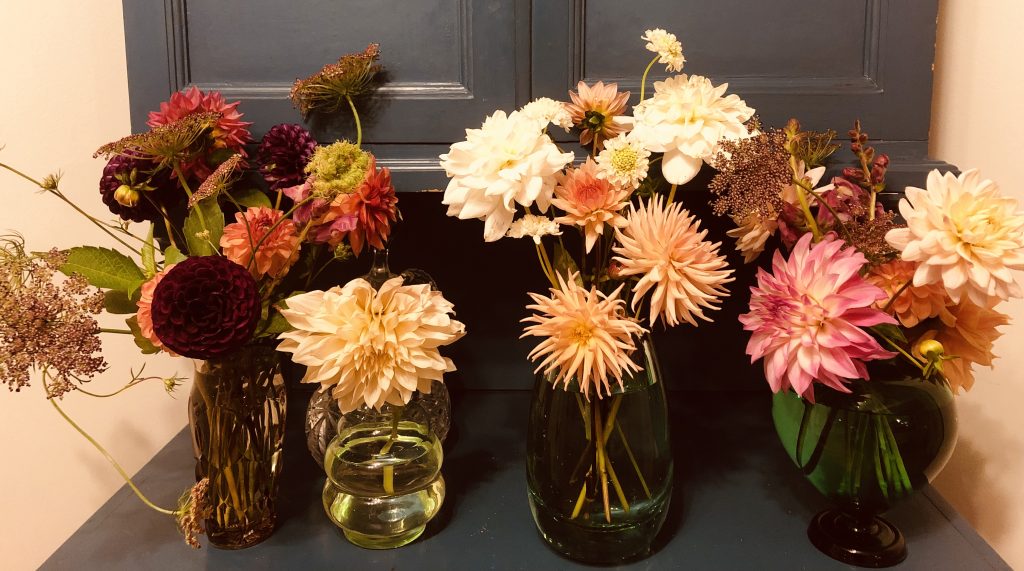Storing Dahlia tubers
When the cold weather and frost arrive, it’s time to lift and store the dahlia tubers for the winter. Dahlia tubers are full of energy and ready to grow in the next season, but they cannot withstand freezing temperatures. They need to be dug up and stored in a frost-free environment. By doing this, you also have the opportunity to divide the tubers in spring, which allows you to have more plants. It’s beneficial for your wallet and the environment. In this article, we will provide a step-by-step guide on how to accomplish this and explain the reasons behind it. Get ready to ensure the survival and abundance of your dahlia garden!
Why should you store Dahlias?
Dahlias give a huge flower extravaganza all summer and fall until the first frost hits the gentle leaves. If you want cut flowers for beautiful arrangements or a single flower to put in a pretty vase, dahlias are the right choice for your garden as they give a large number of flowers for a small effort.
The Dahlia flower, which originates from Mexico, does not survive cold climates and the parts that grow above ground crumble in the first night of frost. During the season, the tubers grow in the soil, where they store energy to survive until the next season. But the tubers don’t even survive a shorter period of ice-cold ground, they have to be dug up to survive the winter.
But, instead of throwing the tubers away or letting them die in the soil during winter, they can be dug up and stored in a frost-free room. You can also separate the tubers in order to get more plants and share them with friends and family. A perfect giveaway at a garden party. Good for the wallet, good for the environment!
‘Fairway Spur’

‘Preference’

‘Colorado Classic’

Storing tubers when the frost comes, don’t stress it
There is no need to stress out and dig up the bulbs for a small frostbite. Cold air does not necessarily mean that the ground is frozen. The green parts of the plant will wither, but the tubers will not be effected. On the contrary, it may be good to leave them in the soil to mature a bit more. This way they will get a thicker shell which helps to keep the tubers moist during the winter storage.
- Cut all stems, leaving around 10-20 cm above ground.
- Place name tags close to or on each plant.
- Use some soil or leaves to cover the plants. This will protect them against frost in the air.
Lift the Dahlia tubers
After a few nights of frost in a row it is time to lift up the tubers. Trust your gut feeling when the right time is for you. If you want to be very accurate, you can measure the temperature in the ground, it should not be below 0 C/32 F.
- Use a large garden fork, that you stick in the ground around the plant. The tubers might have grown a lot during summer, so be sure to leave enough space around, in order to not damage them.
- Gently pull up the tubers by grabbing the stems. If they are stuck, carve some more, around and under the plant.
- Shake the plant to loosen up the dirt.
Remaining soil around the tubers may contain mold spores, so some suggest removing as much soil as possible. Some even rinse them clean with water. At the same time, the soil can help retain moisture in the tubers, acting as an extra protective layer. It’s also a matter of the effort and time one has to take care of the tubers, especially if there are many. - Trim away the thin roots that grow out from the tubers. Some experts say they should not be trimmed since the tubers are sensitive when lifted from the soil. They recommend doing it in spring when replanting. If the tubers start to develop mold, it usually begins in the tangle of roots, and that’s a reason to clip them off.
Winter Storage of Dahlias
Winter storage of tubers is the most delicate and tricky part. It’s essential to store them in an environment that is adequately ventilated, moderately humid, and moderately cool. If it’s too dry, the tubers will dry out and not survive, and if it’s too damp, they will develop mold. The space should ideally maintain a temperature between 4 and 10 degrees Celsius (39-50 degrees Fahrenheit), and it’s advantageous if it’s dark.
How the storage should be done depends on the conditions in the space available to you. Below are some examples of how you can store the tubers. Choose the method that suits your circumstances and based on the materials you have at hand. If possible, it’s good if they are not in direct contact with each other. This way, a moldy tuber won’t spread mold to the surrounding tubers.
- As they are in airy baskets or crates. If you choose this method, you don’t need to be too concerned about removing the soil. At Sofiero castle, known for its Dahlia quarter, they do it this way.
- Encase them in peat. Peat is good at regulating moisture and absorbs or releases moisture depending on the surrounding humidity.
- Encase them in sand. This is done by professional Dahlia growers. When you buy tubers, you often see traces of sand on them.
- Wrap them individually in newspaper and place them in paper bags.
- Wrap them in plastic wrap and store them in the refrigerator. Not the most practical method, perhaps, but that’s how the American Dahlia Society does it with extra delicate and rare varieties. We have tried it with varying results. Some became moldy, but a few survived.
Note: Do not place cardboard boxes, bags, or baskets directly on a cool basement floor. Moisture tends to crawl up from the floor and then struggles to dissipate, resulting in moldy tubers. I have made that mistake myself.
During the winter months, it’s good to occasionally check on the tubers. Remove any moldy parts or entire tubers and gently spray them with a little water if they appear very dry.
Feel free to try different storage methods to see what works best for your storage space. Don’t forget to record your storage process in Gardenize and make notes on what worked well or not so well.
Dividing Dahlia Tubers
The suitable time to divide large tubers is in the spring, before they are pre-grown or planted. If done before or during the storage period, there is a risk of creating large wounds on the tubers where mold can easily take hold.
Save your Dahlia learnings in Gardenize
Feel free to try different methods to determine which one works best for your winter storage. If a method doesn’t work well, it’s not wise to repeat it the following year. However, remember to note in Gardenize the approach you took for winter storage of dahlias. It’s not easy to remember after a year has passed.
Here’s what you can do:
Create an activity in Gardenize called “Winter Storage.” Attach one or more types of dahlias to it. In the notes field, write down how you stored them and follow up with a note in the spring about how the dahlia tubers fared during winter.

More to read about Dahlias:
Images published on the Gardenize website belong to Gardenize AB and may not be used without permission.






